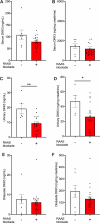Peritoneal and renal DKK3 clearance in peritoneal dialysis
- PMID: 39179976
- PMCID: PMC11342714
- DOI: 10.1186/s12882-024-03715-7
Peritoneal and renal DKK3 clearance in peritoneal dialysis
Abstract
Background: Urinary Dickkopf 3 (DKK3) excretion is a recently established biomarker of renal functional development. Its excretion into the peritoneal cavity has not been reported. We here studied DKK3 in peritoneal dialysis.
Methods: DKK3 was assessed in serum, urine and dialysate in a prevalent adult peritoneal dialysis cohort and its concentration analyzed in relation to creatinine and clinical characteristics.
Results: Highest DKK3 concentrations were found in serum, followed by urine. Dialysate concentrations were significantly lower. Dialysate DKK3 correlated with both other compartments. Serum, dialysate and urine values were stable during three months of follow-up. Continuous ambulatory dialysis (CAPD) but not cycler-assisted peritoneal dialysis (CCPD) volume-dependently increased peritoneal DKK3 in relation to creatinine. RAAS blockade significantly decreased urinary, but not serum or peritoneal DKK3.
Conclusion: Our data provide a detailed characterization of DKK3 in peritoneal dialysis. They support the notion that the RAAS system is essential for renal DKK3 handling.
Keywords: DKK3; Peritoneal dialysis; RAAS blockade.
© 2024. The Author(s).
Conflict of interest statement
The authors declare no competing interests.
Figures





Similar articles
-
Comparison of volume overload with cycler-assisted versus continuous ambulatory peritoneal dialysis.Clin J Am Soc Nephrol. 2009 Jun;4(6):1044-50. doi: 10.2215/CJN.00020109. Epub 2009 Apr 30. Clin J Am Soc Nephrol. 2009. PMID: 19406971 Free PMC article. Clinical Trial.
-
Can the inflammation markers of patients with high peritoneal permeability on continuous ambulatory peritoneal dialysis be reduced on nocturnal intermittent peritoneal dialysis?Perit Dial Int. 2006 May-Jun;26(3):341-8. Perit Dial Int. 2006. PMID: 16722027 Clinical Trial.
-
Pyridinium crosslinks in patients on haemodialysis and continuous ambulatory peritoneal dialysis.Nephrol Dial Transplant. 1995 Dec;10(12):2290-4. doi: 10.1093/ndt/10.12.2290. Nephrol Dial Transplant. 1995. PMID: 8808228
-
The renin-angiotensin-aldosterone system in peritoneal dialysis: is what is good for the kidney also good for the peritoneum?Kidney Int. 2010 Jul;78(1):23-8. doi: 10.1038/ki.2010.90. Epub 2010 Mar 24. Kidney Int. 2010. PMID: 20336052 Review.
-
Advances and insights for DKK3 in non-cancerous diseases: a systematic review.PeerJ. 2025 Feb 13;13:e18935. doi: 10.7717/peerj.18935. eCollection 2025. PeerJ. 2025. PMID: 39959827 Free PMC article.
References
MeSH terms
Substances
LinkOut - more resources
Full Text Sources

